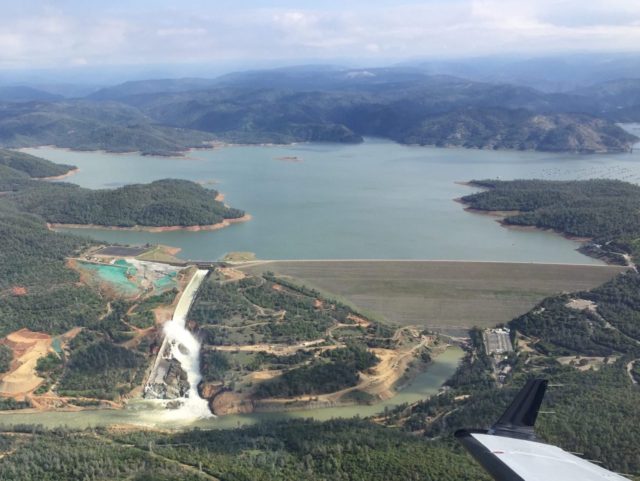A team of University of California infrastructure risk management experts has warned that patches of green foliage growing on the face of Oroville Dam are indications of water saturation in the earthen structure that could cause a catastrophic collapse.
Robert G. Beaa and Tony Johnson of UC Berkeley’s Center for Catastrophic Risk Management led a 15-member multi-campus and multi-disciplinary team in compiling a forensic report, “Root Causes of the Oroville Gated Spillway Failures and Other Developments.”
The highly-detailed 124-page report blasts the State of California’s management of the nation’s tallest dam by highlighting potential dishonesty regarding four major areas of failure:
1) Persistent existing ‘Leaks’ and ‘Wet Spots’ on and around the dam …
2) Persistent existing ‘Cracks’ in the Gated Spillway Headworks reinforced concrete supporting structure and broken and cracked gate anchor ‘tendons’ …
3) Progressive failures of the Gated Spillway and historic ‘patchwork’ repairs … and
4) DWR – DSOD mis-management ‘liabilities’
The report states that the original management failure was failing to excavate all brittle “incompetent rock” overlying hard “competent” granite rock during initial construction of the dam.
Once the dam was completed with a weak base, dam managers allowed, or were encouraged by environmentalists to allow, large trees and other “vigorous vegetation” to grow adjacent to the spillway walls. Their roots could intrude below the base slabs and into the subgrade drainage pipes, resulting in reduced flow and blockage of draining pipes.
Researchers highlight that the biggest continuing risk is the persistence of visible “wet spots” that support the growth of grass and other foliage on the face of the Oroville Dam. Such seepage represents water porting through the saturated earthen dam and then creating erosion channels on the dam’s face. As a result, the researchers state, “Oroville Dam may be facing a breach danger from a serious and a dangerous form of a slow motion failure mode of the left abutment of the dam.”
The team finds no credibility in the Department of Water Resources’ public statements that the “green spot” is from rain or a “natural spring.” If the cause were rain, there would be green spots dispersed across many areas of the dam face, instead of concentrating on the right side about two-thirds of the way up the dam face. Assigning blame to a natural spring flowing from the dam’s base especially lacks credibility, since water does not flow uphill.
The report states that Oroville Dam leaking is probably a symptom of “a dangerous failure mode from an effect known as “differential Ssettlement”:
This phenomenon occurs by sections of the dam “compacting” at a different rate. Thus, internal forces are applied to the center of the dam that has known to cause loss of the integrity of the core, cracking of the core, clogging of the internal drainage system, and longitudinal cracking along the interface between embankment zone fill materials. … A first sign of this alarming problem would be unexplained seepage, wet spots, or greening areas on the back side of the dam (to which Oroville Dam is exhibiting).

COMMENTS
Please let us know if you're having issues with commenting.